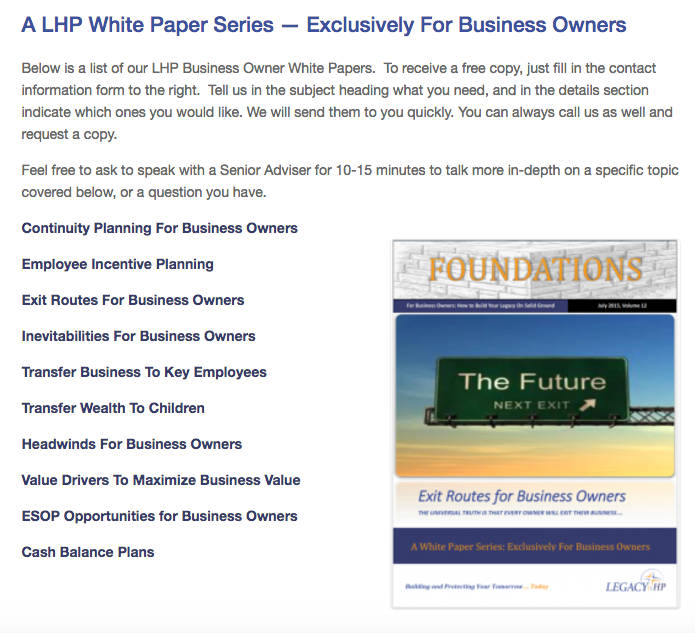The business continuity agreement is the single most important document that the owners of a closely held business will ever sign. This agreement (also known as a buy-and-sell or buy-sell agreement) controls the transfer of ownership when certain events occur. These events include: the death or disability of a shareholder, an involuntary termination or retirement of a shareholder and even (yes they do happen) disputes among owners.
In this four-part series of articles about buy-sell agreements, we assume that, like most successful co-owned companies, your company has, in place, a buy-sell agreement. In our experience, however, many, if not most, of these agreements do not reflect either the current circumstances of the business or the owners’ current wishes regarding business continuity. When that is the case, an outdated buy-sell agreement may cause more problems than having no agreement at all! Let’s examine why.
Your first buy-sell agreement (and maybe the one you still have) was likely created when your business was in its infancy, had little value and even less complexity. The most significant continuity issue contemplated was the death of a shareholder. If one owner wanted to leave, the buyout, if any, would cost little. In fact, the most reasonable response might have been to liquidate the business. A comprehensive buy-sell agreement addressing all possible events that can trigger a sale and purchase of ownership was not only unnecessary, the legal fees to create such an agreement may have exceeded the value of your company!
But you, your business, and your co-owner(s) have likely changed mightily since those early days. Has your buy-sell agreement kept up?
This series of articles explores the reasons to review and to revise the buy-sell agreement, what events a buy-sell can and should cover and finally, how valuation can and should work in these agreements.
So, take a look at a copy of your buy-sell agreement (it’s probably where you keep those other “important” documents — in the bottom drawer of your desk), and ask yourself a few questions:
- When was this document last reviewed? If the answer is never or more than two years ago, it needs to be reviewed now. In the early years of the business it probably wasn’t vital to review the buy-sell every year or so because business conditions and value and shareholder aspirations (both personal and business) didn’t change significantly. But today, change is the norm:
- business value may increase or decrease more in one year than the total business value of your company in its startup years;
- owners inch closer to retirement or a desire to sell the company;
- or young co-owners who worked as a group during the early years now have different outlooks, different work ethics, and perhaps different health situations.
In short, your buy-sell agreement now needs to address all of the issues that could trigger a transfer of ownership. The next issue of this newsletter discusses seven trigger events successful owners should consider including in their buy-sell agreements.
- Would I rather make decisions about how to cash out a departing shareholder now or when tempers are flaring? Decisions about how to put out a fire before there’s even a whiff of smoke in the air are hard enough to make. Attempting to find solutions that are fair to all parties when emotions run high is nearly impossible. In the company’s formative years, it wasn’t critical to consider how a lifetime buyout would be structured and valued because the value was minimal. Today it is and unless your buy-sell agreement fully addresses how to cash out departing shareholders, it becomes a ticking time bomb.
To help you prepare for your meeting with your advisors, let’s review a few key items in your buy-sell agreement:
- Who is included in the Agreement? Who has voting control? Are there any changes in either who is included or in the proportions of ownership since you last reviewed the document?
- What events are covered in the Agreement? (Look for a comprehensive list in the next issue of The Exit Planning Review™ )
- Transfer events (death, disability, business disputes, etc.) trigger either mandatory or optional buyouts. The choices you made about what event triggers mandatory buyouts vs. which trigger optional buyouts may no longer be the best choices. As companies grow in value (and have more cash on hand) shareholders more often choose the mandatory buyout option.
- How does your buy-sell agreement determine how the amount of future buyouts will be calculated? In the third part of this series, we’ll look at several ways to establish value and which methods work best.
- Finally, look at how you’ve decided to fund particular types of buyouts. If, for example, there is a life insurance funding a buyout of a deceased shareholder, is it in a sufficient amount? Is the policy owned by the proper party? Are the beneficiary designations correct? If a lifetime buyout of an owner is expected, how can that buyout best be (at least partially) pre-funded and designed to minimize overall taxes?
This quick list should give you plenty to discuss at your next meeting with your advisors. If you aren’t convinced you should schedule that meeting, our next issue will summarize some of the events that can and do occur in the life of any business. If your buy-sell agreement does not cover these events, you and your company may be more vulnerable than you ever imagined.
Take care and have a good day,
Michael
ABOUT LEGACYHP: Our passion is our mission -- To position our clients into a positive, energized, posture -- within your businesses and within your lives -- So that you manage change confidently, take decisive action, and enjoy life's journey Today... while you enjoy building your Legacy for Tomorrow.
Notice: The information contained in this article is general in nature and is not legal, tax or financial advice. For information regarding your particular situation, contact an attorney or a tax or financial advisor. The information in this newsletter is provided with the understanding that it does not render legal, accounting, tax or financial advice. In specific cases, clients should consult their legal, accounting, tax or financial advisor. This article is not intended to give advice or to represent our firm as being qualified to give advice in all areas of professional services. Exit Planning is a discipline that typically requires the collaboration of multiple professional advisors. To the extent that our firm does not have the expertise required on a particular matter, we will always work closely with you to help you gain access to the resources and professional advice that you need.



